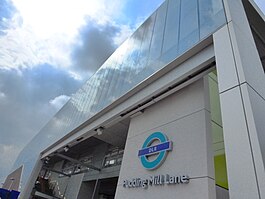Pudding Mill Lane DLR station
| Pudding Mill Lane |
|
|---|---|

New station, opened in April 2014
|
|
|
Location of Pudding Mill Lane in Greater London
|
|
| Location | Queen Elizabeth Olympic Park |
| Local authority | Newham |
| Managed by | Docklands Light Railway |
| Number of platforms | 2 |
| Accessible | Yes |
| Fare zone | 2 and 3 |
| DLR annual boardings and alightings | |
| 2012 |
|
| 2013 |
|
| 2014 |
|
| 2015 |
|
| Key dates | |
| 15 January 1996 | Opened |
| 18 April 2014 | Original station closed permanently |
| 28 April 2014 | Re-sited station opened |
| Other information | |
| Lists of stations | |
| WGS84 | 51°32′03″N 0°00′50″W / 51.5341°N 0.0138°WCoordinates: 51°32′03″N 0°00′50″W / 51.5341°N 0.0138°W |
|
|
|
Pudding Mill Lane is a station on the Docklands Light Railway (DLR) in directly next to the Stratford district of the Queen Elizabeth Olympic Park in the London Borough of Newham, Greater London. It opened in 1996 on the road of the same name, in a light industrial area. It is next to the Olympic Park; however, it was closed for the duration of the 2012 Olympic Games and reopened on 12 September 2012. The original island platform station was permanently closed on 18 April 2014 in order to allow for the construction of a ramp from the new Crossrail portal nearby. A new, larger station built a short distance to the south opened on 28 April 2014.
The station is located on the DLR's Stratford branch, between the Bow Church and Stratford stations and is on the boundary between Travelcard Zone 2 and Zone 3.
The plans for the DLR to Stratford included an option for a station at Pudding Mill Lane. Funding was not available to build the station, but the location was one of two places safeguarded for future development, the other being Langdon Park.
Pudding Mill Lane was opened on 15 January 1996. Previously this location had been a simple passing point for trains on the otherwise single-tracked section between Stratford and Bow Church.
The name of the station is taken from the nearby Pudding Mill Lane which, in turn, takes its name from the former Pudding Mill River, a minor tributary of the River Lea. This is believed to have taken its name from St. Thomas's Mill, a local water mill shaped like a pudding and commonly known as Pudding Mill. The area had also been called Knob Hill up until the 1890s.
...
Wikipedia

